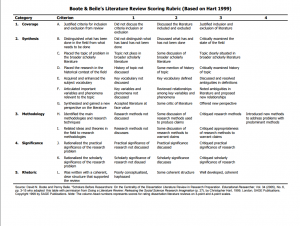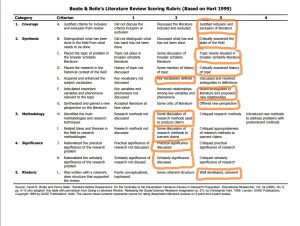Literature Review Overview
In our EDCI 515 course this week, we were given the task to read ‘Scholars Before Researchers’ by Boote and Beile to learn more about literature reviews. Literature reviews are commonly written at the beginning of research articles as a way to share collated information on a specific topic. According to the authors, literature reviews should “advance our collective understanding, a researcher or scholar needs to understand what has been done before, the strengths and weaknesses or existing studies, and what they might mean” (Boote & Beile, 2005). In research, specifically educational research, it is challenging to communicate with the diverse audience. Therefore, authors cannot assume knowledge, methodologies, or even common problems. Because of this, the need for a thorough literature review helps to even the playing field for everyone.
However, these authors have found through personal experience, that a large percentage of literature reviews are poorly planned and written and don’t meet their expectations for appropriate and holistic reviews. Boote and Beile quote a fellow researcher in the field, suggesting that “literature reviews should meet three criteria: to present results of similar studies, to relate the present study to the ongoing dialogue on the literature, and to provide a framework for comparing the results of a study with other studies” (Creswell, 1994). A past criteria was adapted and incorporated into a 12-item scoring rubric which can be grouped into 5 separate sections (see below).

The researchers deemed this rubric effective after they applied and analyzed doctoral dissertations and found that the mean scores across all institutions were surprisingly low. However, because of the range of outcomes, they knew it was going to be an effective tool.
Literature Review of Interest
Since my teacher education days, I have been curious and interested in inquiry based teaching. My younger siblings attended an IB PYP school in West Vancouver and it was fascinating to see their interest, engagement, and knowledge of concepts increase throughout the years (until they reached high school – but I’ll save that for another blog post). Since becoming a teacher, I have integrated inquiry methods into my classroom. The launch of the redesigned curriculum has also allowed for more inquiry and competency based teaching and learning to happen in learning spaces. I am always looking for ways to improve my teaching and build a stronger understanding of my role in an inquiry classroom.
I found an article online that reviews the literature on the role of the teacher in inquiry based classrooms. I am going to use Boote and Beile’s literature review rubric to evaluate, in my perspective, the validity of the information provided (Dobber et al., 2017). See the image below.

I found this article very thorough in its background research, clear in their inclusions and exclusions of data in their collection, and specific in their communication of the results of their findings.
How does a literature review impact the four R’s?
I can see how the inclusion of a literature review can be extremely helpful in creating a well rounded contextual understanding of a specific area of interest.
Research – As mentioned in the Boote and Beile’s article, “a thorough, sophisticated literature review is the foundation and inspiration for substantial, useful research” (2005). By including a literature review into an article, it provides researchers the opportunity to see what has already been done in the field of study and identify where gaps are in understanding. By figuring that out, the researcher then has a clearer picture of what kind of research methodology would be the best approach to target the question.
Researcher – The incorporation of a literature review will help to build the researchers background knowledge on a topic and to build their foundational understanding in order to make effective research decisions.
As referenced in our recent readings, anyone can be a researcher, as long as you follow the protocol and structure of the methodologies.
Researched – One of the benefits of a literature review is it automatically forces researchers to look for information on the topic before moving forward with their own data collection. Information has to be systematically sorted, organized, and analyzed in order to understand the specific problem and subjects to include in the research.
Reader – By including a literature review to writing, it allows the reader to have a clear understanding of the background and history of a topic and why the researcher made the choices they did. It also allows for a cyclical process for the reader of the data to initiate research into the same area where there continues to be gaps or confusion. It also provides the reader with a clear history of where they need to check to get background information.
Personal Reflection
As I reflect on the readings and guest speakers this week, I have noted some personal growth in relation to myself as a researcher, the research, the researched, and the reader of the research.
- All of the research methodologies have advantages and challenges. Something that George Veletsianos noted in his conversation with us this week was to remember that when we are collecting quantitative data, we can’t forget about the humanity in the study of people. In order to have research that is well rounded and provides context, researchers should include qualitative methodologies as he does with his personal interviews (mixed methods).
- I think the incorporation of sources outside of the academic world could provide some great insight into topics of research. Someone in class brought up a great point that one of the Inquiry books they were reading by Trevor Mackenzie had only a handful of academic sources and instead, referenced thoughts, images, and examples from blogs and social media sites online. Is there much research to integrate sources like that into academia? If so, what are the guidelines around it?
- As I begin to learn more and more about the different methodologies, I begin to think about my approach to my classroom. As teachers we are always collection quantitative and qualitative data in order to progress and plan for what is next. These mixed methods and action research methodologies are all new to me and are providing me with ideas about how to be intentional about what I am doing with that data.
- Honestly, my assessment has definitely declined over the last year or so. Learning about these methodologies makes me think about what data I am collecting over the year, what I am doing with it, and how am I using it to guide my practice. How can I move through the action research process with the inclusion of quantitative and qualitative components?
- action research to determine how I can improve my teaching in order to reach my wide range of learners more effectively, without completely burning out
- quantitative data collection for students and their understanding of topics (sent out on FreshGrade at regular intervals)
- qualitative data collection for students and their parents in order to get insight into their developing understanding of concepts, problem solving, and collaboration
- action research as a school to move through how we come together to build a stronger community to improve the learning for our students
Recent Comments